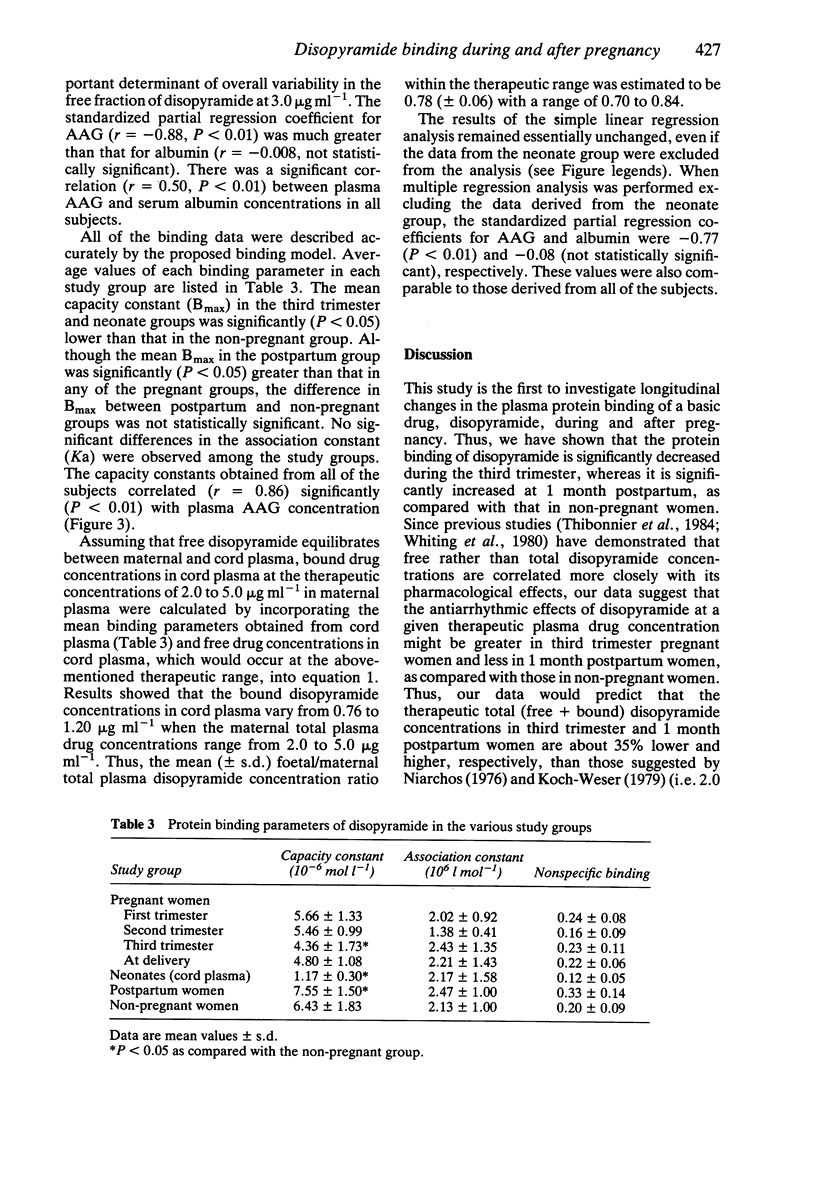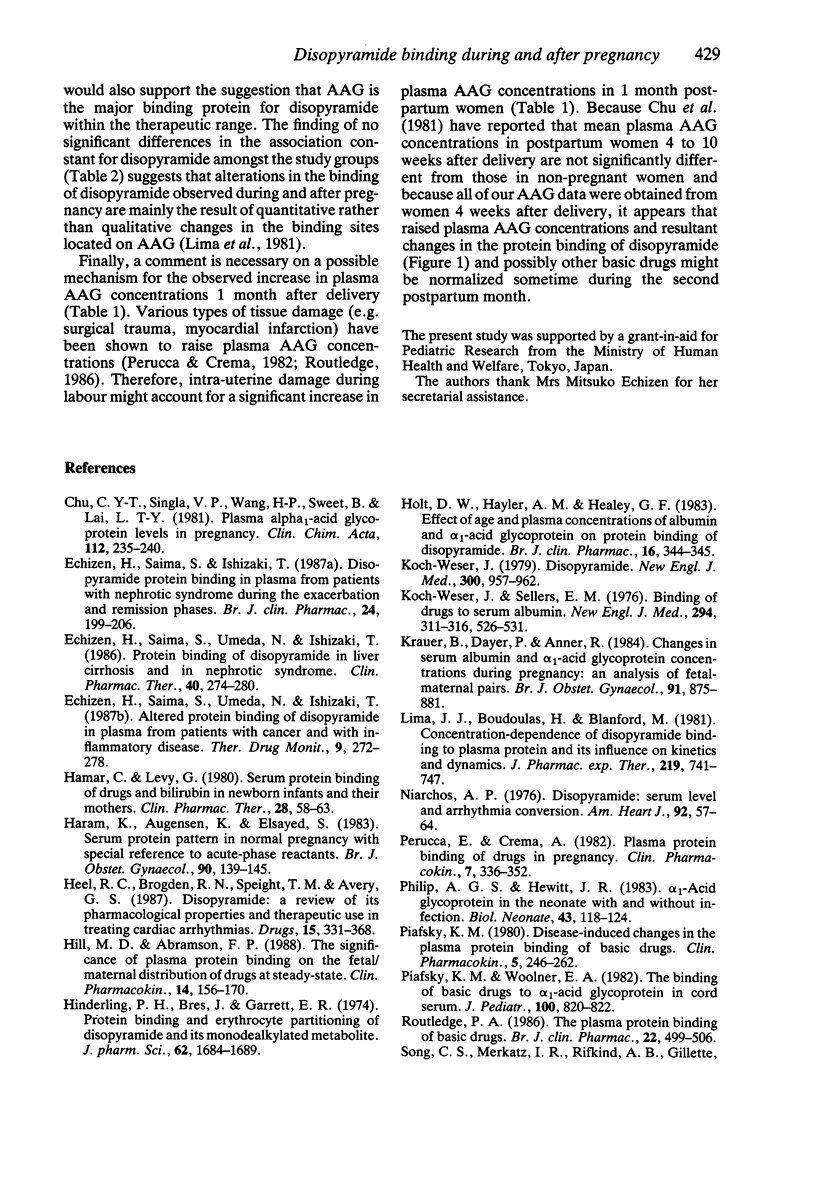Abstract
1. The protein binding of disopyramide was measured in plasma obtained from nonpregnant women, pregnant women in the first, second, and third trimesters, matched pairs of mothers and neonates (cord plasma), and 1 month postpartum women (n = 6 or 8 of each). 2. Plasma samples spiked with 0.2-12.0 micrograms ml-1 of the drug were ultrafiltered and the free fractions were measured with a fluorescent polarization immunoassay. 3. The mean (+/- s.d.) percentages of free drug at a total concentration of 3.0 micrograms ml-1 observed in the third trimester (46 +/- 9%) and neonate (79 +/- 5%) groups were greater (P less than 0.05 or 0.01) than that in the non-pregnant group (34 +/- 7%). In contrast, the corresponding value observed in the postpartum group (23 +/- 8%) was less (P less than 0.05) than that in the non-pregnant group. In addition, there was a significant (P less than 0.01) difference in the mean percentage of free drug at 3.0 micrograms ml-1 in plasma from mothers (43 +/- 9%) and neonates (79 +/- 5%). 4. A multiple regression analysis indicated that alpha 1-acid glycoprotein (r = -0.88, P less than 0.01), rather than albumin (r = -0.008), dominated the binding of disopyramide within the therapeutic range of drug concentration. An analysis of the binding parameters of disopyramide suggested that alterations in binding were attributable to changes in the capacity rather than the affinity of binding.(ABSTRACT TRUNCATED AT 250 WORDS)
Full text
PDF







Selected References
These references are in PubMed. This may not be the complete list of references from this article.
- Chu C. Y., Singla V. P., Wang H. P., Sweet B., Lai L. T. Plasma alpha 1-acid glycoprotein levels in pregnancy. Clin Chim Acta. 1981 May 5;112(2):235–240. doi: 10.1016/0009-8981(81)90382-x. [DOI] [PubMed] [Google Scholar]
- Echizen H., Saima S., Ishizaki T. Disopyramide protein binding in plasma from patients with nephrotic syndrome during the exacerbation and remission phases. Br J Clin Pharmacol. 1987 Aug;24(2):199–206. doi: 10.1111/j.1365-2125.1987.tb03162.x. [DOI] [PMC free article] [PubMed] [Google Scholar]
- Echizen H., Saima S., Umeda N., Ishizaki T. Altered protein binding of disopyramide in plasma from patients with cancer and with inflammatory disease. Ther Drug Monit. 1987 Sep;9(3):272–278. doi: 10.1097/00007691-198709000-00004. [DOI] [PubMed] [Google Scholar]
- Echizen H., Saima S., Umeda N., Ishizaki T. Protein binding of disopyramide in liver cirrhosis and in nephrotic syndrome. Clin Pharmacol Ther. 1986 Sep;40(3):274–280. doi: 10.1038/clpt.1986.175. [DOI] [PubMed] [Google Scholar]
- Hamar C., Levy G. Serum protein binding of drugs and bilirubin in newborn infants and their mothers. Clin Pharmacol Ther. 1980 Jul;28(1):58–63. doi: 10.1038/clpt.1980.131. [DOI] [PubMed] [Google Scholar]
- Haram K., Augensen K., Elsayed S. Serum protein pattern in normal pregnancy with special reference to acute-phase reactants. Br J Obstet Gynaecol. 1983 Feb;90(2):139–145. doi: 10.1111/j.1471-0528.1983.tb08898.x. [DOI] [PubMed] [Google Scholar]
- Heel R. C., Brogden R. N., Speight T. M., Avery G. S. Disopyramide: a review of its pharmacological properties and therapeutic use in treating cardiac arrhythmias. Drugs. 1978 May;15(5):331–368. [PubMed] [Google Scholar]
- Hill M. D., Abramson F. P. The significance of plasma protein binding on the fetal/maternal distribution of drugs at steady-state. Clin Pharmacokinet. 1988 Mar;14(3):156–170. doi: 10.2165/00003088-198814030-00004. [DOI] [PubMed] [Google Scholar]
- Hinderling P. H., Bres J., Garrett E. R. Protein binding and erythrocyte partitioning of disopyramide and its monodealkylated metabolite. J Pharm Sci. 1974 Nov;63(11):1684–1690. doi: 10.1002/jps.2600631103. [DOI] [PubMed] [Google Scholar]
- Holt D. W., Hayler A. M., Healey G. F. Effect of age and plasma concentrations of albumin and alpha 1-acid glycoprotein on protein binding of disopyramide. Br J Clin Pharmacol. 1983 Sep;16(3):344–345. doi: 10.1111/j.1365-2125.1983.tb02175.x. [DOI] [PMC free article] [PubMed] [Google Scholar]
- Koch-Weser J. Disopyramide. N Engl J Med. 1979 Apr 26;300(17):957–962. doi: 10.1056/NEJM197904263001705. [DOI] [PubMed] [Google Scholar]
- Koch-Weser J., Sellers E. M. Drug therapy. Binding of drugs to serum albumin (second of two parts). N Engl J Med. 1976 Mar 4;294(10):526–531. doi: 10.1056/NEJM197603042941005. [DOI] [PubMed] [Google Scholar]
- Krauer B., Dayer P., Anner R. Changes in serum albumin and alpha 1-acid glycoprotein concentrations during pregnancy: an analysis of fetal-maternal pairs. Br J Obstet Gynaecol. 1984 Sep;91(9):875–881. doi: 10.1111/j.1471-0528.1984.tb03700.x. [DOI] [PubMed] [Google Scholar]
- Lima J. J., Boudoulas H., Blanford M. Concentration-dependence of disopyramide binding to plasma protein and its influence on kinetics and dynamics. J Pharmacol Exp Ther. 1981 Dec;219(3):741–747. [PubMed] [Google Scholar]
- Niarchos A. P. Disopyramide: serum level and arrhythmia conversion. Am Heart J. 1976 Jul;92(1):57–64. doi: 10.1016/s0002-8703(76)80403-6. [DOI] [PubMed] [Google Scholar]
- Perucca E., Crema A. Plasma protein binding of drugs in pregnancy. Clin Pharmacokinet. 1982 Jul-Aug;7(4):336–352. doi: 10.2165/00003088-198207040-00004. [DOI] [PubMed] [Google Scholar]
- Philip A. G., Hewitt J. R. Alpha 1-acid glycoprotein in the neonate with and without infection. Biol Neonate. 1983;43(3-4):118–124. doi: 10.1159/000241618. [DOI] [PubMed] [Google Scholar]
- Piafsky K. M. Disease-induced changes in the plasma binding of basic drugs. Clin Pharmacokinet. 1980 May-Jun;5(3):246–262. doi: 10.2165/00003088-198005030-00004. [DOI] [PubMed] [Google Scholar]
- Piafsky K. M., Woolner E. A. The binding of basic drugs to alpha-acid glycoprotein in cord serum. J Pediatr. 1982 May;100(5):820–822. doi: 10.1016/s0022-3476(82)80603-3. [DOI] [PubMed] [Google Scholar]
- Routledge P. A. The plasma protein binding of basic drugs. Br J Clin Pharmacol. 1986 Nov;22(5):499–506. doi: 10.1111/j.1365-2125.1986.tb02927.x. [DOI] [PMC free article] [PubMed] [Google Scholar]
- Song C. S., Merkatz I. R., Rifkind A. B., Gillette P. N., Kappas A. The influence of pregnancy and oral contraceptive steroids on the concentration of plasma proteins. Studies with a quantitative immunodiffusion method. Am J Obstet Gynecol. 1970 Sep 15;108(2):227–231. doi: 10.1016/0002-9378(70)90301-7. [DOI] [PubMed] [Google Scholar]
- Thibonnier M., Holford N. H., Upton R. A., Blume C. D., Williams R. L. Pharmacokinetic-pharmacodynamic analysis of unbound disopyramide directly measured in serial plasma samples in man. J Pharmacokinet Biopharm. 1984 Dec;12(6):559–573. doi: 10.1007/BF01059552. [DOI] [PubMed] [Google Scholar]
- Thomas J., Long G., Moore G., Morgan D. Plasma protein binding and placental transfer of bupivacaine. Clin Pharmacol Ther. 1976 Apr;19(4):426–434. doi: 10.1002/cpt1976194426. [DOI] [PubMed] [Google Scholar]
- Tucker G. T., Boyes R. N., Bridenbaugh P. O., Moore D. C. Binding of anilide-type local anesthetics in human plasma. II. Implications in vivo, with special reference to transplacental distribution. Anesthesiology. 1970 Sep;33(3):304–314. doi: 10.1097/00000542-197009000-00006. [DOI] [PubMed] [Google Scholar]
- Whiting B., Holford N. H., Sheiner L. B. Quantitative analysis of the disopyramide concentration-effect relationship. Br J Clin Pharmacol. 1980 Jan;9(1):67–75. doi: 10.1111/j.1365-2125.1980.tb04799.x. [DOI] [PMC free article] [PubMed] [Google Scholar]
- Wood M., Wood A. J. Changes in plasma drug binding and alpha 1-acid glycoprotein in mother and newborn infant. Clin Pharmacol Ther. 1981 Apr;29(4):522–526. doi: 10.1038/clpt.1981.73. [DOI] [PubMed] [Google Scholar]
- Yamaoka K., Tanigawara Y., Nakagawa T., Uno T. A pharmacokinetic analysis program (multi) for microcomputer. J Pharmacobiodyn. 1981 Nov;4(11):879–885. doi: 10.1248/bpb1978.4.879. [DOI] [PubMed] [Google Scholar]


